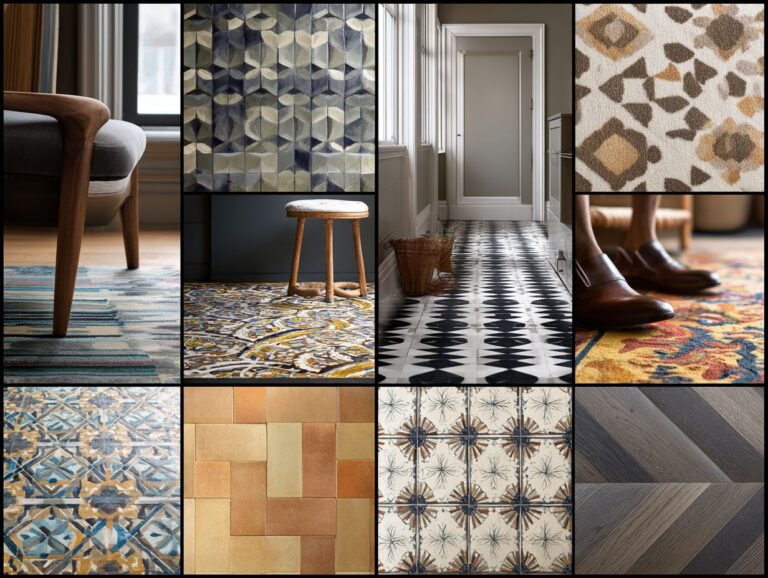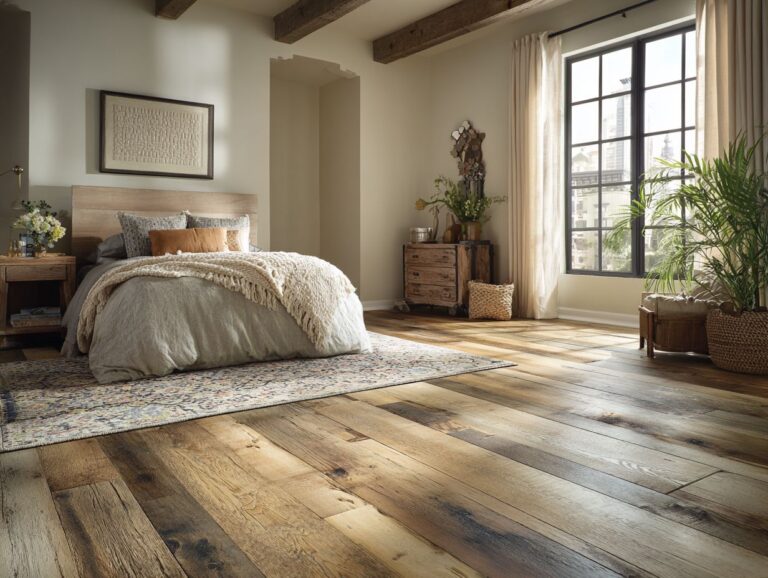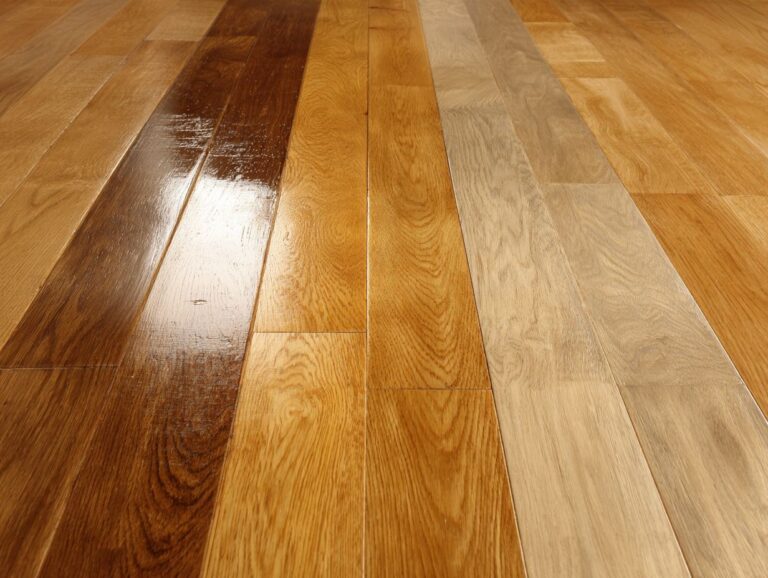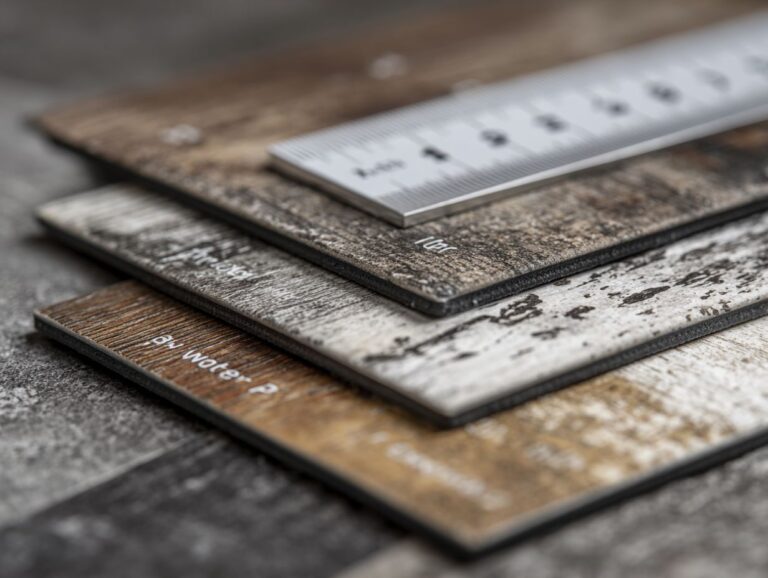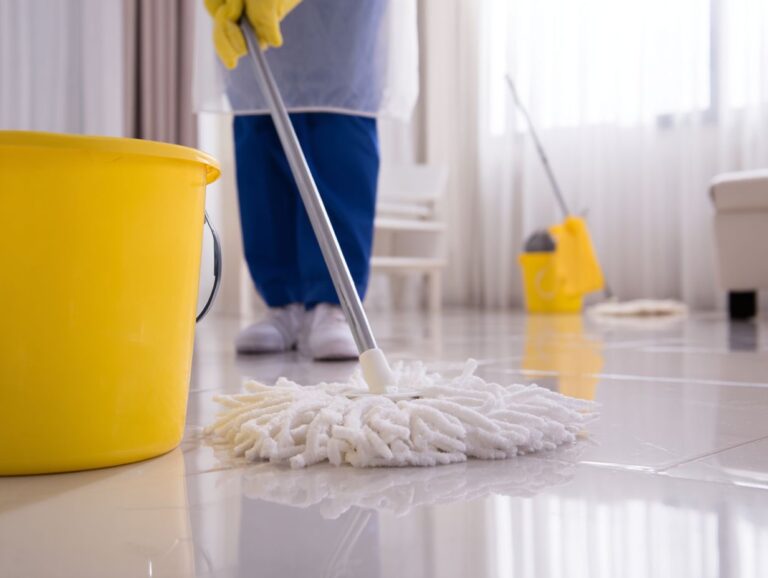Hardwood Floor Cleaning – Daily, Weekly, Deep Clean Guide
Contents
- Introduction to Hardwood Floor Cleaning
- Hardwood Floor Maintenance and Renovation Market
- Daily Cleaning Routine
- Weekly Cleaning Routine
- Deep Cleaning Hardwood Floors
- Preventative Maintenance Tips
- Special Considerations
- Frequently Asked Questions
- How often should hardwood floors be cleaned?
- What is the best method for daily hardwood floor cleaning?
- What is included in a weekly hardwood floor cleaning?
- How often should hardwood floors be deep cleaned?
- What are the benefits of regularly cleaning hardwood floors?
- Can I use a steam cleaner on hardwood floors?
Introduction to Hardwood Floor Cleaning
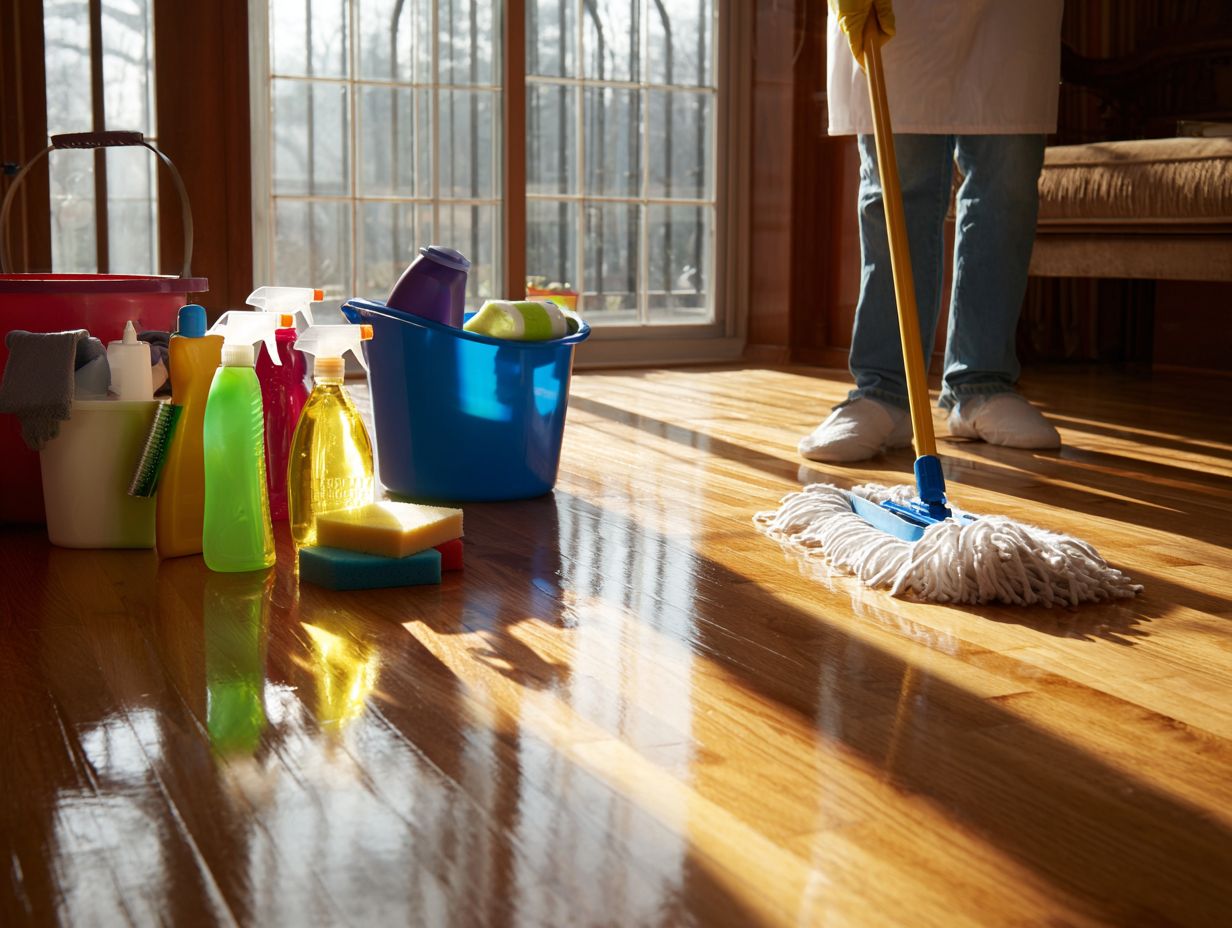
Key Takeaways:
Importance of Maintaining Hardwood Floors
Regular maintenance protects hardwood floors from wear and tear, extending their lifespan and maintaining their value.
If you don’t take care of hardwood floors, they might only last 10-15 years. If you clean them with a pH-neutral cleaner, refinish them every 5 to 7 years, and place area rugs on them, they can last up to 50 years.
Investing in a good quality cleaner and scheduling routine professional refinishing can prevent costly repairs in the long run. Homes with well-maintained floors can increase in value by up to 10%, so it’s sensible to keep them in good condition. Related insight: Understanding Flooring Janka Hardness Ratings can further aid in choosing the right materials for your hardwood flooring.
Hardwood Floor Maintenance and Renovation Market
Hardwood Floor Maintenance and Renovation Market
When designing a space that combines functionality and style, considering flooring options is crucial. For instance, choosing the right bathroom flooring can significantly impact both the aesthetics and usability of the space. Our Bathroom Flooring Guide provides insights on waterproof and slip-resistant options that are essential for safety and durability in such environments.
Market Growth Statistics: Market Value Growth
The Hardwood Floor Maintenance and Renovation Market Data shows information about the industry’s financial development and expected trends. Knowing these statistics can aid stakeholders in making smart choices about investments, market plans, and growth opportunities.
Market Growth Statistics indicate significant expansion over the next decade. The market size in 2023 is valued at $3.1 billion, highlighting the substantial demand for hardwood floor maintenance and renovation services.
Looking forward, the projected market size for 2032 is expected to reach $5.2 billion. This notable increase underlines the growing popularity of hardwood flooring due to its aesthetic appeal and durability, along with the rising trend of home improvement and renovation projects.
- Compound Annual Growth Rate (CAGR): The industry is predicted to grow at a 5.7% CAGR from 2023 to 2032. The continuous growth rate shows ongoing consumer interest and indicates a reliable market, making it a good choice for investment.
Overall, the Hardwood Floor Maintenance and Renovation Market demonstrates a positive outlook with substantial growth potential. Companies in this sector can make use of these trends by developing new maintenance methods, broadening their range of services, and increasing customer satisfaction to help the market grow.
Overview of Cleaning Methods
It’s important to know how to clean hardwood floors properly, including daily upkeep, weekly cleaning, and deep cleaning.
-
Daily care involves sweeping or using a microfiber mop to remove debris and prevent scratches.
-
To clean hardwood floors each week, combine a floor cleaner with water. Make sure the mop is slightly wet, not dripping, to prevent any harm.
-
Deep cleaning should be done every few months using a special wood floor cleaner to get rid of stubborn dirt. Tools like a buffer can also help restore shine.
By following this routine, you’ll preserve the beauty and longevity of your hardwood floors while avoiding costly repairs. If interested, you might also want to learn about common flooring installation mistakes that could affect your floors’ overall health.
Daily Cleaning Routine
Doing a daily cleaning routine can greatly cut down on dirt build-up and keep the hardwood floors looking shiny.
Tools Needed for Daily Cleaning
Essential tools for daily hardwood floor cleaning include a microfiber mop, a soft cloth, and a dust mop, which effectively trap dust and dirt.
To improve your hardwood cleaning routine, try the O-Cedar ProMist microfiber mop ($10-$20). It makes damp cleaning easy without using too much water.
Pair this with a soft cloth for polishing, like the e-Cloth ($15), which lifts grime and leaves surfaces streak-free. A dust mop such as the Swiffer Sweeper ($13) can quickly handle daily dust accumulation.
Together, these tools provide an efficient, eco-friendly cleaning approach, ensuring your floors stay pristine without harsh chemicals.
Steps for Daily Cleaning
- Dust with a mop,
- Clean up spots,
- Mop with water,
- Dry the floor,
- Let fresh air in.
To complete your cleaning routine fast, spend 15-20 minutes on it each day.
Start by dusting, using a microfiber mop to capture more dust and allergens. For spot cleaning, immediately tackle any stains with a suitable cleaner, allowing it to sit briefly for effectiveness.
Next, use a damp mop with a pH-neutral solution to avoid residue. After mopping, dry the floor with a clean cloth to prevent slips.
Open windows to improve airflow and dry surfaces, which helps get rid of leftover smells.
Common Mistakes to Avoid

Avoid common mistakes like using excessive water, harsh chemicals, or neglecting to sweep regularly, which can damage hardwood floors.
One significant mistake is using vinegar and water, which can dull the finish over time. Instead, opt for a pH-neutral cleaner designed for hardwood floors.
Another error is neglecting to use protective pads under furniture, leading to scratches; invest in felt pads to avoid this.
Failing to sweep or vacuum regularly allows dirt to accumulate, leading to damage. Commit to a weekly cleaning routine with a soft-bristle broom or a vacuum designed for hardwoods to preserve your floors’ sheen.
Weekly Cleaning Routine
Regular weekly cleaning of hardwood floors prevents dirt buildup and keeps them in good shape.
Tools Needed for Weekly Cleaning
Tools for a weekly clean include a commercial hardwood floor cleaner like Bruce Hardwood & Laminate Floor Cleaner ($10), and optional beeswax polish for added shine.
To improve your cleaning tasks, try using a microfiber mop. It picks up dust and dirt well without damaging the floor. Pair it with a vacuum specifically designed for hardwood floors to remove debris before mopping.
For stubborn spots, a diluted mixture of white vinegar and water can be applied with a cloth for a natural solution. Picking non-toxic brands like Method or Seventh Generation keeps your family and the environment safe and takes care of your floors.
Steps for Weekly Cleaning
To effectively clean hardwood floors weekly:
- Sweep or vacuum thoroughly,
- Apply hardwood floor cleaner,
- Mop with a damp cloth, and
- Allow to dry completely.
Start by choosing the right vacuum, ensuring it has a soft-bristle attachment to prevent scratches. After sweeping, use a pH-neutral hardwood floor cleaner; brands like Bona or Method are excellent choices.
When mopping, dampen a microfiber cloth a little and avoid soaking the floor to prevent water damage. Let the floor dry for about 30 minutes to remove any leftover cleaning product and keep it shiny.
For deeper cleaning, consider a monthly polish application to preserve the wood’s finish.
How to Handle Stains and Spills
Quickly address stains and spills; clean most spills using a solution of dish soap and water.
For tough stains, mix white vinegar with baking soda. Start by blotting the area with a clean cloth to absorb excess liquid.
Then, apply a solution of one cup vinegar mixed with two cups water. For better results, sprinkle baking soda on the surface before using the cloth to clean.
Be sure to test any solution on an inconspicuous area first to avoid damage. This approach is particularly effective for old pet stains or coffee spills, providing a natural, non-toxic cleaning option for your home.
Deep Cleaning Hardwood Floors
Clean hardwood floors every season to make them look fresh and get rid of accumulated dirt. For tips on maintaining your floor’s pristine condition, including managing furniture-induced dents, explore our furniture dents removal techniques.
When to Deep Clean
It’s a good idea to clean deeply twice a year or when you notice dirt and grime.
To determine if it’s time for a deep clean, look for signs like a noticeable dullness on surfaces, an increase in allergens, or accumulation of dust in corners.
Setting a calendar alert twice a year can help you stay organized.
To thoroughly clean, pay attention to areas that are frequently touched, like:
- Doorknobs
- Light switches
- Kitchen countertops
Equip yourself with essential tools like:
- A steam cleaner for carpets and upholstery
- Microfiber cloths for dusting
- A high-efficiency particulate air (HEPA) vacuum to reduce allergens effectively.
Tools Needed for Deep Cleaning
For deep cleaning, you’ll need a commercial cleaner, a heavy-duty mop, and optional repair kits for scratches, such as liquid scratch concealers.
Commercial cleaners like Zep (around $15) are designed to tackle tough dirt, making them ideal for deep cleaning. Pair this with a heavy-duty mop, such as the O-Cedar EasyWring ($20), to effectively lift and remove dirt.
To address scratches, consider a liquid scratch concealer, such as the Rejuvenate (approximately $10), which can restore the finish on hardwood floors.
By choosing these particular tools, your thorough cleaning will be more effective than using regular cleaning products.
Steps for Deep Cleaning
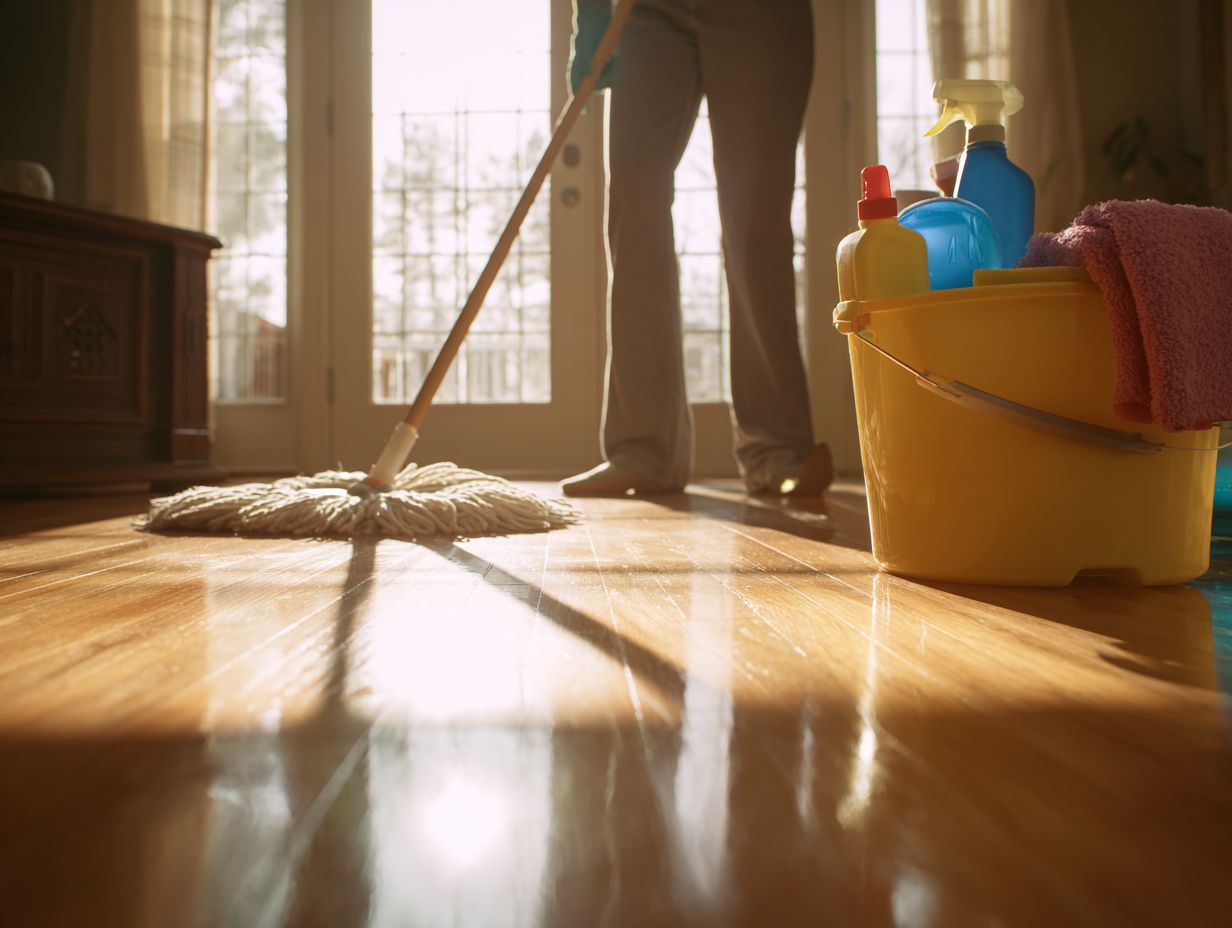
- Remove furniture
- Vacuum thoroughly
- Use a deep-cleaning solution
- Mop and rinse
- Dry the floor completely
Once you move the furniture, use a vacuum with a HEPA filter to remove dust and allergens thoroughly, which should take about 30 minutes.
For the deep-cleaning solution, consider a mixture of warm water and a few drops of dish soap or a commercial floor cleaner like Mr. Clean. Use a microfiber mop to apply the solution evenly.
After mopping, rinse the floor with clean water to prevent leftover cleaner, which can take an extra 30 minutes to dry.
Allow at least 1-2 hours for the floor to dry before moving furniture back.
Drying and Finishing Touches
Properly drying your hardwood floors is essential; use fans to improve airflow and manage indoor humidity after cleaning.
Excess moisture can lead to warping and mildew, compromising the wood’s integrity. Aim for humidity levels between 30-50% to maintain optimal conditions.
Utilizing a hygrometer helps monitor humidity effectively; these devices are widely available for under $20. Positioning dehumidifiers in damp areas can further reduce moisture.
Regularly inspect the floors for signs of water damage, especially after cleaning. If needed, change how you clean or the tools you use to take care of your hardwood flooring and make it last longer.
Preventative Maintenance Tips
Doing regular upkeep can greatly lessen the chances of major repairs needed for hardwood floors.
Protecting Floors from Scratches
To protect hardwood floors from scratches, use area rugs in high traffic zones and place floor mats at entry points.
Additional strategies include using felt pads under furniture legs to prevent sliding scratches.
For small scratches, use beeswax polish to cover the damage and provide protection.
When moving furniture, lift instead of dragging to avoid surface damage.
Regularly clean your floors with a soft broom or microfiber cloth to eliminate grit that can cause scratches.
Think about using a polyurethane sealant to make the surface last longer and resist damage.
Humidity and Temperature Control
Keeping indoor humidity between 30-50% helps stop hardwood floors from warping or cracking.
To achieve the ideal humidity, consider investing in a humidifier or dehumidifier.
For instance, a quality humidifier ranges from $50 to $300, and models like the Honeywell HCM-350 are effective for larger spaces, providing uniform moisture. Conversely, if your environment is too humid, a dehumidifier like the Frigidaire FFAP5033W1 can help, costing around $200.
Checking humidity with a hygrometer helps keep it at the right level, which protects your wood floors and improves comfort inside throughout the year.
Special Considerations
Choosing the correct cleaning products is important to keep hardwood floors looking good and lasting a long time.
Cleaning Products to Avoid
Avoid cleaning products with harsh chemicals, such as ammonia and bleach, as they can damage the wood finish over time.
Instead, opt for gentler alternatives like vinegar mixed with water or biodegradable cleaners specifically designed for wood surfaces.
For instance, brands like Method or Seventh Generation offer non-toxic cleaning solutions that effectively remove dirt without compromising wood integrity.
Consider using microfibre cloths to dust, as they trap particles without scratching the finish.
Using these products regularly will keep your wood in good condition and make it last longer by protecting it from harsh chemicals.
Eco-Friendly Cleaning Solutions
Cleaning products such as vinegar and baking soda are effective and eco-friendly.
You can make simple yet powerful cleaners using these ingredients.
For a basic all-purpose cleaner, mix equal parts vinegar and water in a spray bottle, adding a few drops of lemon essential oil for a pleasant scent.
For tough stains, combine baking soda and water to form a paste. Apply it to the stained spot for 15 minutes, then scrub.
Don’t forget about essential oils: tea tree oil is an excellent natural antibacterial.
These products clean well and make your home smell nice without harmful chemicals.
Recap of Cleaning Routines
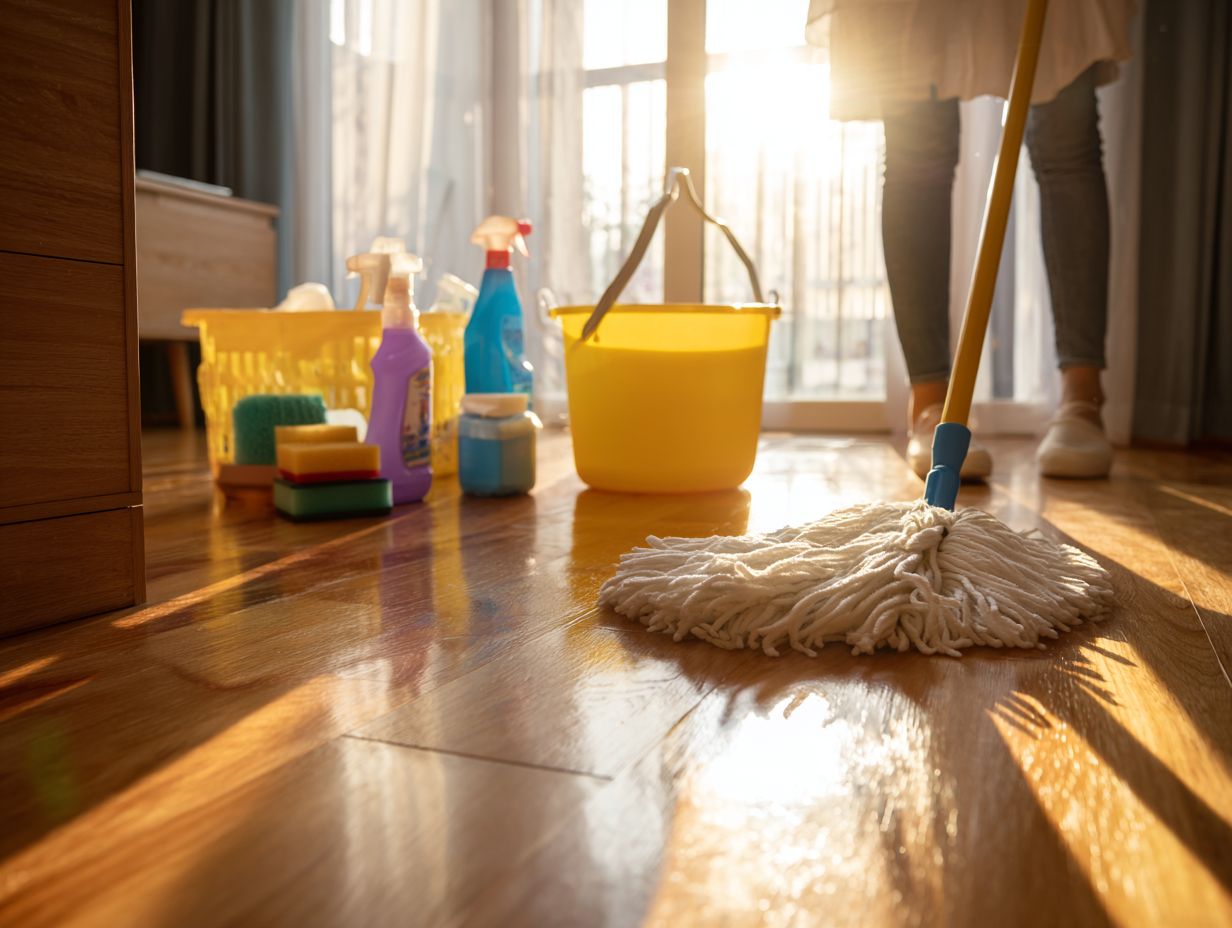
To recap, maintaining hardwood floors involves regular cleaning routines that include daily upkeep, weekly deep cleans, and seasonal care.
Daily upkeep should include sweeping or vacuuming to remove dust and dirt, which prevents scratches on the wood surface.
For weekly deep cleans, use a damp microfiber mop with a pH-neutral cleaner specifically designed for hardwood, ensuring not to saturate the floor.
Seasonal care might involve using a wood conditioner or polish to improve the finish and shield the wood.
This careful method helps your hardwood last longer and stay in great condition all year.
Final Tips for Longevity of Hardwood Floors
To keep hardwood floors in good condition for a long time, regularly maintain them, use appropriate cleaning products, and manage humidity levels.
- Regularly sweep or vacuum your hardwood floors to eliminate dirt and debris that can scratch the surface.
- Use a microfiber mop with pH-neutral cleaner, ideally bi-monthly, to maintain shine without damaging the finish.
- Invest in a humidity monitor to keep moisture levels between 35-55%. This prevents warping or gaps due to fluctuations.
- To maintain its condition over time, reapply a coat of polyurethane every couple of years.
- Place area rugs in high-traffic zones to minimize wear, ensuring your floors remain beautiful and durable.
Frequently Asked Questions
How often should hardwood floors be cleaned?
You should clean hardwood floors daily, give them a thorough clean each week, and do a detailed clean every few months to maintain their appearance.
What is the best method for daily hardwood floor cleaning?
Daily maintenance for hardwood floors can be done by simply sweeping or vacuuming to remove any dirt and debris. Use a soft cloth or mop for spot cleaning any spills or stains.
What is included in a weekly hardwood floor cleaning?
A weekly cleaning for hardwood floors should include mopping with a damp, not wet, cloth or mop to remove any built-up grime and give the floors a fresh shine.
How often should hardwood floors be deep cleaned?
Thoroughly clean hardwood floors every 3-4 months, based on how often people walk on them. This involves using a specialized hardwood floor cleaner and a microfiber mop for a thorough cleaning.
What are the benefits of regularly cleaning hardwood floors?
Cleaning hardwood floors regularly keeps them looking good and lasts longer by stopping dirt and debris from scratching and harming them.
Can I use a steam cleaner on hardwood floors?
No, it is not recommended to use a steam cleaner on hardwood floors as the high heat and moisture can cause damage and warping. Stick to using a damp cloth or mop for cleaning and avoid excessive water on the floors.
